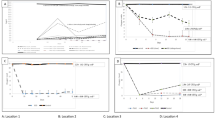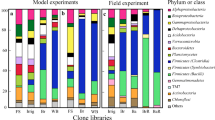Abstract
Background
Anaerobic soil disinfestation (ASD) has been proven to be an effective and environmentally friendly method for controlling soil-borne plant diseases. Mechanisms of ASD-mediated pathogen suppression are not fully elucidated but appear to depend on the carbon (C) sources used and involve a combination of abiotic and biotic factors. This study sought to assess the impacts of ASD with different C sources on soil chemical properties, microbial activity, and antagonistic compounds, and identify the major factor(s) driving suppression of tomato bacterial wilt caused by Ralstonia solanacearum.
Methods
A pot experiment was conducted containing five treatments, i.e., untreated control (CK), anaerobic treatment without C source (ASD-CK), anaerobic treatment with rice bran (ASD-R), wheat bran (ASD-W) and peanut bran (ASD-P).
Results
All the ASD treatments significantly reduced disease incidence by 83–100% and simultaneously promoted tomato growth, while anaerobic treatments with C sources achieved a better effect than anaerobic treatment alone. This could be associated with the improved soil chemical (lowered Eh, NO3−, SO42− and elevated pH) and biological (elevated dehydrogenase and urease activities) properties and elevated production of antagonistic compounds (Fe2+, Mn2+, citric acid, succinic acid, and ammonia) by anaerobic treatments with C sources. Redundancy analysis further indicated that the elevated ammonia (11.1%, P = 0.002), Mn2+ (5.3%, P = 0.002), citric acid (1.8%, P = 0.046) and urease activity (1.0%, P = 0.036) were the major factors driving disease suppression, which all achieved the highest value in ASD-P.
Conclusions
In summary, the incorporation of organic materials that improve antagonistic compounds (especially ammonia) production could induce higher inhibition effect against tomato bacterial wilt during the ASD process.






Similar content being viewed by others
References
Blok WJ, Lamers JG, Termorshuizen AJ, Bollen GJ (2000) Control of soilborne plant pathogens by incorporating fresh organic amendments followed by tarping. Phytopathology 90:253–259
Butler DM, Kokalis-Burelle N, Albano JP, McCollum TG, Muramoto J, Shennan C, Rosskopf EN (2014) Anaerobic soil disinfestation (ASD) combined with soil solarization as a methyl bromide alternative: vegetable crop performance and aoil nutrient dynamics. Plant Soil 378:365–381
Butler DM, Ownley BH, Dee ME, Eichler Inwood SE, McCarty DG, Shrestha U, Kokalis-Burelle N, Rosskopf EN (2014) Low carbon amendment rates during anaerobic soil disinfestation (ASD) at moderate soil temperatures do not decrease viability of Sclerotinia sclerotiorum sclerotia or fusarium root rot of common bean. Acta Horticult 1044:203–208
Butler DM, Rosskopf EN, Kokalis-Burelle N, Albano JP, Muramoto J, Shennan C (2012) Exploring warm-season cover crops as carbon sources for anaerobic soil disinfestation (ASD). Plant Soil 355:149–165
Cameron KC, Di HJ, Moir JL (2013) Nitrogen losses from the soil/plant system: a review. Ann Appl Biol 162:145–173
Di Gioia F, Ozores-Hampton M, Zhao X, Thomas J, Wilson P, Li Z, Hong J, Albano J, Swisher M, Rosskopf E (2017) Anaerobic soil disinfestation impact on soil nutrients dynamics and nitrous oxide emissions in fresh-market tomato. Agr Ecosyst Environ 240:194–205
Diogo RVC, Wydra K (2007) Silicon-induced basal resistance in tomato against Ralstonia solanacearum is related to modification of pectic cell wall polysaccharide structure. Physiol Mol Plant P 70:120–129
Gambrell RP (1996) Manganese. In: Sparks DL, Page AL, Helmke PA, Loeppert RH, Soltanpour PN, Tabatabai MA, Johnston CT, Sumner ME (eds) Methods of Soil Analysis Part 3-Chemical Methods. Soil Science Society of America, American Society of Agronomy, Madison, WI, pp 665–682
Goud J-KC, Termorshuizen AJ, Blok WJ, van Bruggen AHC (2004) Long-term effect of biological soil disinfestation on Verticillium wilt. Plant Dis 88:688–694
Hewavitharana SS, Ruddell D, Mazzola M (2014) Carbon source-dependent antifungal and nematicidal volatiles derived during anaerobic soil disinfestation. Eur J Plant Pathol 140:39–52
Huang XQ, Liu LL, Wen T, Zhang JB, Wang FH, Cai ZC (2016) Changes in the soil microbial community after reductive soil disinfestation and cucumber seedling cultivation. Appl Microbiol Biot 100:5581–5593
Huang XQ, Wen T, Zhang JB, Meng L, Zhu TB, Liu LL, Cai ZC (2015) Control of soil-borne pathogen Fusarium oxysporum by biological soil disinfestation with incorporation of various organic matters. Eur J Plant Pathol 143:223–235
Husson O (2013) Redox potential (Eh) and pH as drivers of soil/plant/microorganism systems: a transdisciplinary overview pointing to integrative opportunities for agronomy. Plant Soil 362:389–417
Jin C, Zhu J, Li M, Zhao B (2013) A greenhouse study on the dynamics of organic acids in the rhizosphere of wheat and maize. J Arid Land Resour Environ 27:86–91
Ju X-T, Xing G-X, Chen X-P, Zhang S-L, Zhang L-J, Liu X-J, Cui Z-L, Yin B, Christie P, Zhu Z-L, Zhang F-S (2009) Reducing environmental risk by improving N management in intensive Chinese agricultural systems. Proc Natl Acad Sci U S A 106:3041–3046
Kandeler E, Poll C, Frankenberger WT, Tabatabai MA (2011) Nitrogen Cycle Enzymes. In: Dick RP (ed) Methods of Soil Enzymology. Soil Science Society of America, Madison, WI, pp 211–245
Khan SA, Mulvaney RL, Hoeft RG (2001) A simple soil test for detecting sites that are nonresponsive to nitrogen fertilization. Soil Sci Soc Am J 65:1751–1760
Li S, Liu Y, Wang J, Yang L, Zhang S, Xu C, Ding W (2017) Soil acidification aggravates bacterial wilt in South China. Front Microbiol 8:703
Liu L, Kong J, Cui H, Zhang J, Wang F, Cai Z, Huang X (2016) Relationships of decomposability and C/N ratio in different types of organic matter with suppression of Fusarium oxysporum and microbial communities during reductive soil disinfestation. Biol Control 101:103–113
Loeppert RH, Inskeep WP (1996) Iron. In: DL Sparks, AL Page, PA Helmke, RH Loeppert, PN Soltanpour, MA Tabatabai, CT Johnston, ME Sumner (eds) Methods of Soil Analysis Part 3-Chemical Methods. Soil Science Society of America, American Society of Agronomy, Madison, 639–664
Meng T, Yang Y, Cai Z, Ma Y (2018) The control of Fusarium oxysporum in soil treated with organic material under anaerobic condition is affected by liming and sulfate content. Biol Fert Soils 54:295–307
Momma N (2008) Biological soil disinfestation (BSD) of soilborne pathogens and its possible mechanisms. Jarq-Jpn Agric Res 42:7–12
Momma N, Kobara Y, Momma M (2011) Fe2+ and Mn2+, potential agents to induce suppression of Fusarium oxysporum for biological soil disinfestation. J Gen Plant Pathol 77:331–335
Momma N, Kobara Y, Uematsu S, Kita N, Shinmura A (2013) Development of biological soil disinfestations in Japan. Appl Microbiol Biotechnol 97:3801–3809
Morgunov IG, Kamzolova SV, Dedyukhina EG, Chistyakova TI, Lunina JN, Mironov AA, Stepanova NN, Shemshura ON, Vainshtein MB (2017) Application of organic acids for plant protection against phytopathogens. Appl Microbiol Biotechnol 101:921–932
Nannipieri P, Ascher-Jenull J, Ceccherini MT, Pietramellara G, Renella G, Schloter M (2020) Beyond microbial diversity for predicting soil functions: A mini review. Pedosphere 30:5–17
Poret-Peterson AT, Albu S, McClean AE, Kluepfel DA (2019) Shifts in soil bacterial communities as a function of carbon source used during anaerobic soil disinfestation. Front Environ Sci 6:160
Poret-Peterson AT, Sayed N, Glyzewski N, Forbes H, Gonzalez-Orta ET, Kluepfel DA (2020) Temporal responses of microbial communities to anaerobic soil disinfestation. Microb Ecol 80:191–201
Posas MB, Toyota K, Islam TMD (2007) Inhibition of bacterial wilt of tomato caused by Ralstonia solanacearum by sugars and amino acids. Microbes Environ 22:290–296
Rousk J, Baath E (2007) Fungal and bacterial growth in soil with plant materials of different C/N ratios. FEMS Microbiol Ecol 62:258–267
Shrestha U, Auge RM, Butler DM (2016) A meta-analysis of the impact of anaerobic soil disinfestation on pest suppression and yield of horticultural crops. Front Plant Sci 7:1254
Šmilauer P, Lepš J (2014) Multivariate analysis of ecological data using Canoco 5. 2nd edn. Cambridge University Press, Cambridge
Strauss SL, Kluepfel DA (2015) Anaerobic soil disinfestation: A chemical-independent approach to pre-plant control of plant pathogens. J Integr Agr 14:2309–2318
Tabatabai MA (1994) Soil Enzymes. In: PS Bottomley, JS Angle, RW Weaver (eds) Methods of Soil Analysis: Part 2-Microbiological and Biochemical Properties. Soil Science Society of America. Madison, 775–833
Tenuta M, Lazarovits G (2002) Ammonia and nitrous acid from nitrogenous amendments kill the microsclerotia of Verticillium dahliae Phytopathology 92:255–264
Tian J, Rao S, Gao Y, Lu Y, Cai K (2021) Wheat straw biochar amendment suppresses tomato bacterial wilt caused by Ralstonia solanacearum: potential effects of rhizosphere organic acids and amino acids. J Integr Agric 20:2450–2462
Wang L, Cai K, Chen Y, Wang G (2013) Silicon-mediated tomato resistance against Ralstonia solanacearum is associated with modification of soil microbial community structure and activity. Biol Trace Elem Res 152:275–283
Wang X, Zou C, Gao X, Guan X, Zhang W, Zhang Y, Shi X, Chen X (2018) Nitrous oxide emissions in Chinese vegetable systems: A meta-analysis. Environ Pollut 239:375–383
Weller DM, Raaijmakers JM, Gardener BBM, Thomashow LS (2002) Microbial populations responsible for specific soil suppressiveness to plant pathogens. Annu Rev Phytopathol 40:309–348
Yang J, Jiao Y, Yang WZ, Gu P, Bai SG, Liu LJ (2018) Review of methods for determination of ammonia volatilization in farmland. IOP Conf Ser: Earth Environ Sci 113:012022
Yao J, Allen C (2006) Chemotaxis is required for virulence and competitive fitness of the bacterial wilt pathogen Ralstonia solanacearum J Bacteriol 188:3697–3708
Yuliar, Nion YA, Toyota K (2015) Recent trends in control methods for bacterial wilt diseases caused by Ralstonia solanacearum Microbes Environ 30:1–11
Zhao J, Mei Z, Zhang X, Xue C, Zhang C, Ma T, Zhang S (2017) Suppression of Fusarium wilt of cucumber by ammonia gas fumigation via reduction of Fusarium population in the field. Sci Rep 7:43103
Acknowledgements
The present study was financially supported by grants from the National Natural Science Foundation of China (31870420, 41807084), the Natural Science Foundation of Guangdong Province, China (2017A030313177, 2018A030310214, 2022A1515011034), the Science and Technology Program of Guangdong Province (2015A050502043, 2121A0505030057) and the Basic Research Program of Guangzhou City, China (202102020390).
Author information
Authors and Affiliations
Contributions
Formal analysis and investigation: Yihang Mao, Taowen Pan, Chaorong Wu and Lei Wang; Writing - original draft preparation: Yihang Mao, Abdul Hafeez and Jihui Tian; Writing - review and editing: Taowen Pan, Joji Muramoto, Carol Shennand, Kunzheng Cai, Jihui Tian; Funding acquisition and supervision: Kunzheng Cai and Jihui Tian.
Corresponding authors
Additional information
Responsible Editor: Stijn Spaepen.
Publisher’s note
Springer Nature remains neutral with regard to jurisdictional claims in published maps and institutional affiliations.
Supplementary Information
Below is the link to the electronic supplementary material.
ESM 1
(DOCX 20.1 KB)
Rights and permissions
About this article
Cite this article
Mao, Y., Hafeez, A., Pan, T. et al. Suppression of tomato bacterial wilt by anaerobic soil disinfestation and associations with production of antagonistic compounds. Plant Soil 477, 539–552 (2022). https://doi.org/10.1007/s11104-022-05452-y
Received:
Accepted:
Published:
Issue Date:
DOI: https://doi.org/10.1007/s11104-022-05452-y




